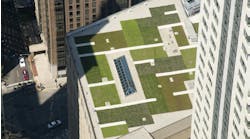Not all plants are suited to the harsh conditions on green roofs. To determine which species would be hardy against extreme weather conditions, pests, and diseases, the Chicago Botanic Garden conducted the largest vegetated roof plant study in the U.S. Five years of research has led to the publication of Plant Evaluation Notes, a report that highlights the best plants for green roofs in Zone 5.
A diverse group of 216 herbaceous and woody taxa was evaluated in growing depths from 3 to 8 inches. Nine taxa received "excellent" ratings for their overall performance and survivability, including Pussytoes, calamints, Green Sargent Juniper, three types of phlox (Apple Blossom, Emerald Blue, and Snowflake), a fragrant sumac called Gro-Low, and two varieties of prairie dropseed.
Top-rated plants consistently displayed good vigor and robust habits, superior ornamental qualities, disease resistance, heat and drought tolerance, and winter hardiness or survivability throughout the evaluation period. Additionally, 69 taxa received "good" ratings for their strong performances.
“Ultimately, the success of a green roof is due to the success of the plants growing on it,” says Richard Hawke, Plant Evaluation Manager at the Chicago Botanic Garden. “Plant trials like the one undertaken here are crucial to increasing the knowledge about the best plants for green roof culture.”
The Plant Conservation Science Center is a 38,000-square-foot, LEED Gold-rated research laboratory with two 8,000-square-foot gardens on the north and south sides of the building’s central clerestory. The Ellis Goodman Family Foundation Green Roof Garden South features regional and national native plants, many of which are not currently used as rooftop plants, while the Josephine P. & John J. Louis Foundation Green Roof Garden North features a mix of plants known as good green roof plants, plus native and exotic plants that have potential for green roof use. Download the full report.


